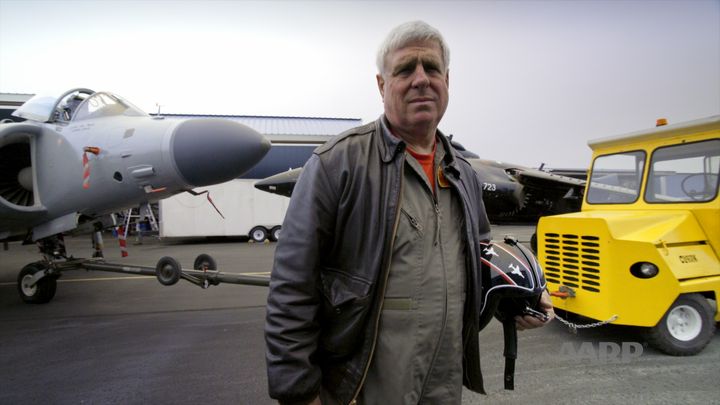
“Very few people thought I’d ever get the plane here in the country, much less fly it,” says Nalls standing in front of the Harrier which can take off vertically.
“Badass Pilot: The Series” is a non-scripted series now published on the AARP You Tube channel. It tells the story of Art Nalls, a former Marine pilot who bought and refurbished a legendary Sea Harrier jump jet. He’s currently the only private owner of the plane in the world.
What in particular appealed to you about the Harrier? Was it the design? Had you flown one when you were in the military? I graduated from the U.S. Naval Academy and was commissioned in the Marine Corps. After pilot training, I was selected for Harrier training at Cherry Point, North Carolina from 1979 until 1984. While there I flew an early version of the Harrier, and I was deployed literally all over the world. I landed on carriers, in small fields, roads, etc, so we put the airplane through its paces. I loved the airplane from my first flight in a two-seat trainer, but also respected it. We had a terrible accident rate, so a good, healthy respect was essential to staying alive. But I love the airplane because it performs like no other-- extremely rapid acceleration, extremely rapid roll rate, extreme rate of climb, and you can land it in a K-Mart parking lot.
You bought the plane from a broker in Britain, but it was shipped to you in the U.S. in pieces. What were the biggest obstacles to actually putting it back together? Spare parts have always been a challenge. The biggest has been the Gas Turbine Starter (GTS for short). It's a small jet engine, about the size of Folgers Coffee can, that produces 87 horse power. Once it starts, it turns the main Pegasus engine until the engine has enough compression to light off. But they are finicky and tend to ‘just blow up.' They are quite spectacular when they do explode, but the real work begins trying to find another one. They haven't been made for years, are scarce, and either very, very expensive or just plain expensive. The cheapest I've paid is about $3,000. But the government price is $250,000. I obviously opt for the cheaper price if I can. I’ve found one on a go-kart and one in a scrap pile in Florida. Almost everywhere I can I look.
You had one near-miss during a test flight when the hydraulic system failed but you were able to land the plane safely. Have here been other near-mishaps and if so what did you do to correct them? The hydraulic failure on the second flight was a serious emergency. Coming out alive was not guaranteed. There have been Marines who've not been as lucky with the same emergency. I was able to safely land the airplane because of my experience, my team, and there being some nice U.S. government concrete at the Naval Air Station landing pad in Pax River, Maryland. Without all of those, I would have had to eject and that's not a guarantee, either. We've had other emergencies in this airplane, but so far, knock on wood, we have been able to handle them.
The Harrier you've rebuilt now appears primarily at air shows around the country. What kinds of questions do spectators ask about it? Are they amazed that this plane can take off and land vertically? Do any of them ask for a free ride in it? We primarily do airshows, as our main source of revenue to keep the business running. We do get requests for rides, but this plane is single seat. We often are able to offer flight training in our L39, which has two seats. We are authorized instructors and our 'students' actually fly the airplane, including steep turns and basic aerobatic maneuvers, such as rolls, etc. We very rarely do any of them free, but sometimes the airshow pays for them for press or sponsor rides.
Why the series name "Badass Pilot?" Your idea or AARP's? AARP selected the name for the series. I personally wouldn't call myself a badass, but in the tradition of military pilot 'callsigns' you're not allowed to pick your own name. Others pick it for you because it 'fits.'